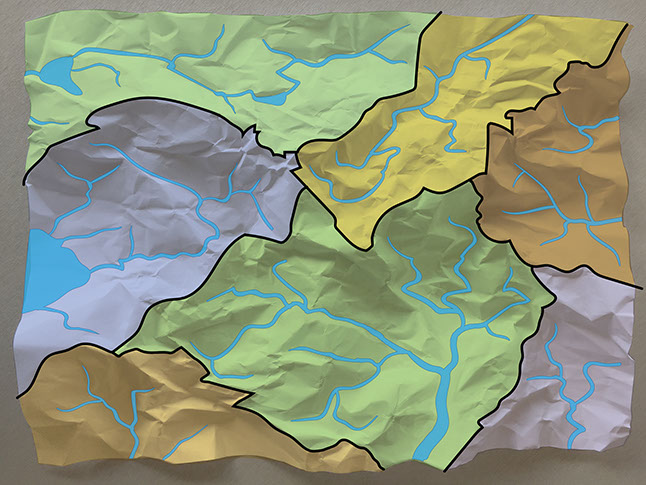SciGen Teacher Dashboard
Unit T2
Models in Science
Is bug spray a big deal?
About Systems and Models
Tracing the Path of Water through a Watershed
Did a model save the bay?
The Proposed Dam
 Lab: Tracing the Path of Water through a Watershed
Lab: Tracing the Path of Water through a Watershed
Duration: Approximately 75 minutes
In this lab, students create a model of a watershed system. They will see how the surface of the land can affect where water flows and they will be asked to think about the way rainfall flows down hillsides into streams, creeks, rivers, and eventually the ocean. All the land that drains water to a certain body of water is called a watershed. Sometimes there are watersheds within watersheds!
LEARNING OBJECTIVE
Students create their own model of a watershed system and evaluate its strengths and weaknesses.
Teacher Tip
- Try labs yourself before leading them with students.
Materials
- map (master provided)
- pencils
- colored markers (not permanent)
- spray bottles
Teacher Tune-ups
Teaching Notes
ACTIVITY OVERVIEW
- Introducing watershed concept (5 min)
- Creating the model (25 min)
- Running the simulation and summarizing observations (35 minutes)
- Discussion of the strengths and weaknesses of the model (15 minutes)
Introducing watershed concept (5 minutes)
Discuss how a particular area or region can drained by a river, creek, or other body of water.
Ask students if they have ideas about what kind of model could demonstrate where substances spilled in nature may end up.






1 - 6
<
>
Cutting and color-coding a simple map (25 minutes)
Students create a color code using the four non-permanent markers (that will run when wet) and color in the structures using the corresponding color. Alternatively, use a blank sheet of paper instead of a map and allow students to make up their own map of house, farms, factories, dumps, etc.
Students cut out and crumple the map provided and smooth it back out, leaving the ridges slightly raised. Students trace over ridge lines with a pencil. Before you allow students to spray their model with mist, ask them to predict what’s going to happen to the colors when they do.
Students should consider and write the potentially dangerous or toxic substances that may be used in each category of land use.
:
- I think that the red ink that represents my farms and the blue ink for my garbage dump are going to end up running together in the low parts of my paper and off the left side. The farm will probably not be affected by the run-off from the garbage dump...I’m a bit concerned about the factories though.

Running the simulation and summarizing observations (35 minutes)
Students simulate rainfall by applying sprays of mist. After each spray, they observe what happens to the land model and how the water flows.
:
- Use a spray bottle of water to create rainfall over your land. Use gentle sprays of mist.
- Observe what happens after every misting.
- As the “rain” continues, observe how the water flows on your land model.
:
- What happened when it “rained” on your model?
- If the marker ink simulates pollution, were there areas where the water became more polluted?
- In your model, where did the water flows end?
- Did anything surprise you?

Discussion of the strengths and weaknesses of the model (15 minutes)
Students consider the effectiveness of their model of the watershed system.
The question on the right can projected or teachers may download the questions.
- Expert Groups: Create small groups and give each group a question. Give expert groups several minutes to discuss their question and to write a response. Each member of the expert group must write a response. (10 mins)
- Teaching Groups: Create new groups with at least one representative from each expert group. Students discuss each question with the expert(s) starting the discussion. Students should take notes from their group members as they discuss and record the names of the members who contributed the information. (15 mins)
- Whole Class: Ask students to share what they discussed when in teaching groups. Ask them to attribute insights and ideas to their group members.
- Students think about questions either individually or with a partner. Write responses to all five questions.
- Lead a class discussion on the questions.
What made this a good model?
example: The model was small and I could see all the areas easily.
In what ways was this NOT a good model?
example: There were no trees in the model.
What might be better ways to model watersheds?
example: Maybe clay would be better than paper.
More questions:
- Why do you think you might want to use a model to study something like a watershed?
- What are other models we use often? Is a map a model? Is a math problem a model? Is a teddy bear a model?
- Can you think of other people besides scientists who might use models?
- How might a model help predict floods? Landslides? Whether buildings would withstand strong earthquakes?
BETA Version - Please send comments and corrections to info@serpinstitute.org